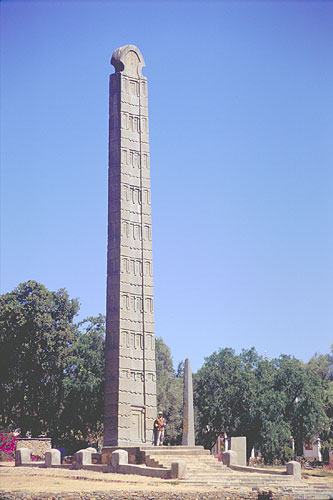
Armed guard and obelisk Axum, Ethiopia
Seldom visited by foreign tourists over the past few decades due to its continuing political problems, Ethiopia is most well known as being the possible cradle of humankind. Fossil remains (the famous Lucy) discovered in northeastern Ethiopia have been dated to roughly 3.5 million years, making them the earliest known example of an upright walking hominid. The oldest known stone tools, dating to 2.4 million years, were also found in this same region. But Ethiopia has numerous other claims to fame, including the mysterious granite obelisks of Axum, the extraordinary rock-hewn churches of Lalibela and - most enigmatic of all - the church of St. Mary of Zion, probable location of the Holy Arc of the Covenant.
The early history of Ethiopia (also called Abyssinia) begins with the glorious but little known kingdom of Axum. The origins of the Axumite state are now dated to the middle of the 2nd century BC. At the height of its power, between the 4th and 7th centuries AD, the Axumite kingdom controlled most of present-day Ethiopia, including territories in the southern parts of the Arabian Peninsula. The Axumite rulers were in regular diplomatic and commercial contact with Egyptian, Greek, Byzantine and Persian empires. The achievements of this grand culture are recorded today in the ruins of its cities, reservoirs, temples and, most remarkably, its towering black granite obelisks.
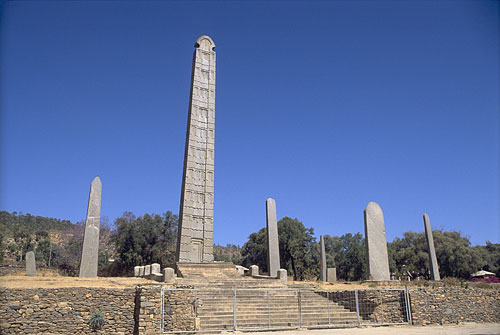
The field of Obelisks, Axum, Ethiopia
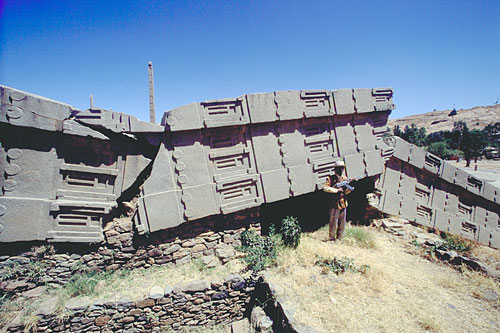
Armed guard and the tallest of the Axumite obelisks, toppled by a mad queen
These obelisks, also called stelae, are known to be the tallest single pieces of stone ever quarried and erected in the ancient world. Their age and use is a complete mystery. Some scholars, extrapolating from ancient coins found at the base of the giant pillars, suggest that they may have been carved and erected around the beginning of the 4th century AD. Due to their proximity to nearby tombs, the obelisks may possibly have been used as memorials to deceased kings and queens, but this is only a speculation. The tallest of the monoliths, now fallen and broken into six massive pieces, was 33.3 meters tall and weighed an estimated five tons (the largest Egyptian obelisk is that of King Tutmosis, 32.16 meters high and now standing in Rome). The tallest obelisk still standing at Axum today is 23 meters. Precisely carved upon its sides (and upon the sides of many other nearby stelae) are what seem to be representations of multiple storeys with floors between them. Each storey features several window-like carvings and, at the base of the obelisks, what appear to be false doors complete with knockers and locks. Are these carvings merely artistic ornamentations or did they have some deeper function?
An even greater mystery surrounds the ancient city of Axum. A few hundred meters from the cluster of towering obelisks is a large walled compound surrounding two churches. Between these two churches, both dedicated to St. Mary of Zion, are the foundational remains of an ancient church and a strange looking, fenced off and heavily guarded “treasury” said to contain the true Arc of the Covenant. Legends tell that long ago this entire area was a swamp inhabited by evil spirits. God helped the local people by coming down to the nearby sacred hill of Makade Egzi and throwing a miraculous dust from heaven that dried up the swamp, dispelled the evil spirits and charged the region with a magical power. Over uncounted centuries shrines were constructed upon the hill and where the swamp had been. Around this holy place grew the cities of pre-Axumite and Axumite kingdoms.
In 331 AD, the Axumite king Ezana was converted to Christianity by the Syrian monk Frumentius. Upon the foundations of the ancient pagan temples, a great church of St. Mary was built in 372 AD. This church, probably the earliest Christian church in sub-Saharan Africa, was visited in the early 1520’s by the Portuguese explorer, Francisco Alvarez. Writing of the church, Alvarez says:
“It is very large and has five naves of a good width and of a great length, vaulted above, and all the vaults are covered up, and the ceiling and sides are all painted; it also has a choir after our fashion ... This noble church has a very large circuit, paved with flagstones, like gravestones, and it has a large enclosure, and is surrounded by another large enclosure like the wall of a large town or city. ”
What factors explain the remarkable grandeur of this church isolated so deep in the remote mountains of northern Ethiopia, so far from the orbit of Christianity? One explanation is that a rich king of a powerful empire built the great church. More compelling is the notion that it was built to house the fabled and enigmatic relic, the Holy Arc of the Covenant.

Courtyard of St. Mary of Zion, Axum, Ethiopia
The Arc of the Covenant and its supposedly divine contents are one of the great mysteries of antiquity. Its story begins with Moses. The traditional founder of Judaism, Moses was born in Egypt, the son of a Hebrew slave. The Hebrews had been in bondage in Egypt for four hundred years from approximately 1650 - 1250 BC. Near the end of this period an Egyptian priest in the service of the Pharaoh made a prophecy that a child would be born to the Hebrews that would one day free them from their slavery. The Pharaoh, on hearing this prophecy, ordered that every male child born to the Hebrews should be killed by drowning. In hopes of preventing his death, Moses' parents placed him in a small basket, which they set adrift on the Nile. He was found by the daughter of the Pharaoh and subsequently raised as an adopted son of the royal family. During his upbringing he was extensively educated in the esoteric and magical traditions of the Egyptian mystery schools. At the age of forty Moses discovered that his original people, the Hebrews, were in bondage to the Egyptians. Enraged at this cruel treatment, he killed an Egyptian overseer and fled into exile into the Sinai wilderness.
Approximately forty years later, while grazing his flocks on the side of Mt.Horeb, Moses came upon a burning bush that was, miraculously, unconsumed by its own flames. A voice speaking out of the fire (Exodus 3:1-13) commanded him to lead his people out of bondage in Egypt and return with them to the mountain. Upon his return Moses twice climbed the mountain to commune with god. Regarding the second ascent, Exodus 24:16-18 states: And the glory of the Lord abode upon Mount Sinai, and the cloud covered it six days; and the seventh day God called unto Moses out of the midst of the cloud. And the appearance of the glory of the Lord was like devouring fire on the top of the mount in the eyes of the children of Israel. And Moses entered into the midst of the cloud, and went up into the mount; and Moses was in the mount fourty days and fourty nights. During this time on the mountain Moses received two tablets upon which God inscribed the Ten Commandments, in addition to precise dimensions for the Arc of the Covenant, which would contain the tablets.
Soon thereafter the Arc, a portable box-like shrine, was constructed and Moses and his people departed from Mt. Sinai. According to archaic textual sources the actual Arc was a wooden chest measuring three feet nine inches long by two feet three inches high and wide. It was lined inside and out with pure gold and was surmounted by two winged figures of cherubim that faced each other across its heavy gold lid. Many scholars believe it may have contained pieces of meteorites or powerful radioactive rocks.
In the ensuing two hundred and fifty years, between the time it was taken from Mt.Sinai to when it was finally installed in the first great Jewish temple in Jerusalem, the Arc was kept for two centuries at Shiloh, was captured by the Philistines for seven months, and then, returned to the Israelites, was kept in the village of Kiriath-Jearim. During this entire time it was associated with numerous extraordinary phenomena, many of which involved the killing or burning of often large numbers of people. Biblical and other archaic sources speak of the Ark blazing with fire and light, inflicting cancerous tumors and severe burns, leveling mountains, stopping rivers, blasting whole armies and laying waste cities.
Passages in the Old Testament give the impression that these happenings were divine actions of Yahweh, the god of the Hebrews. Contemporary scholars, however, believe that there may be another explanation. Writing in his meticulously researched book, The Sign and the Seal (concerning his search for the lost Arc of the Covenant), Graham Hancock suggests that the Arc, and more precisely its mysterious contents, may have been a product of ancient Egyptian magic, science and technology. Moses, being highly trained by the Egyptian priesthood, was certainly knowledgeable in these matters and thus the astonishing powers of the Arc and its “Tablets of the Law” may have derived from archaic Egyptian magic rather than the mythical god Yahweh.
At some unknown date, this awesome object vanished from its place in the Holy of Holies in the Jewish Temple. The date of its disappearance and its subsequent whereabouts has mystified legions of biblical scholars, archaeologists and historians. Among the various explanations given for its disappearance, two are particularly worthy of consideration.
Ethiopian legends say that when the Queen of Sheba made her famous journey to Jerusalem she was impregnated by King Solomon and bore him a son - a royal prince - who in later years stole the Ark. The name of the prince was Menelik, which means "the son of the wise man". Although he was conceived in Jerusalem he was born in Ethiopia where the Queen of Sheba had returned after discovering that she was carrying Solomon's child. When he had reached the age of twenty, Menelik himself traveled from Ethiopia to Israel and arrived at his father's court. There he was instantly recognized and accorded great honor. After a year had passed, however, the elders of the land became jealous of him. They complained that Solomon showed him too much favor and they insisted that he must go back to Ethiopia. This the king accepted on the condition that the first-born sons of all the elders should also be sent to accompany him. Amongst these latter was Azarius, son of Zadok the High Priest of Israel, and it was Azarius, not Menelik, who stole the Ark of the Covenant from its place in the Holy of Holies in the Temple. The group of young men did not reveal the theft to Prince Menelik until they were far away from Jerusalem. When at last they told him what they had done he asserted that they could not have succeeded in so bold a venture unless God had willed its outcome. Therefore he agreed that the Ark should remain with them. Thus Menelik brought the Arc to Ethiopia, to the sacred city of Axum, where it has remained ever since.
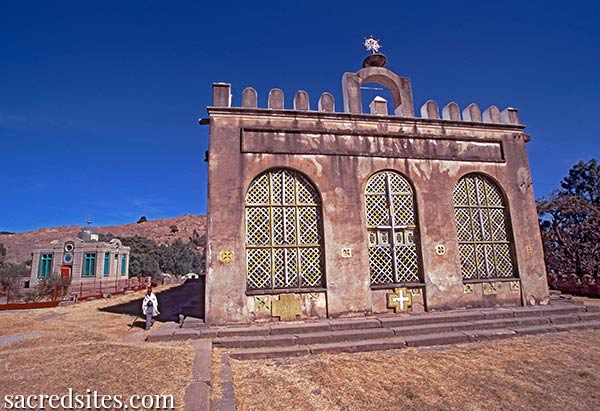
Church of St. Mary of Zion with Treasury of the Arc of the Covenant in background
In The Sign and the Seal, Graham Hancock presents a radically different explanation for the Arc’s disappearance. Based on compelling evidence gathered from years of research, he suggests that Jewish priests from Solomon’s temple removed the Arc during the rule of the apostate King Manasseh (687 - 642 BC). The Arc was then hidden for two hundred years in a Jewish temple on the Egyptian sacred island of Elephantine in the Nile. Next it was taken to Ethiopia, to the island of Tana Kirkos in Lake Tana, where it remained for over 800 years. When the Axumite kingdom converted to Christianity after 331 AD, the Ark of the Covenant was co-opted by the Christian hierarchy and brought from Tana Kirkos to the newly constructed church of St. Mary of Zion in Axum.
The Arc remained in Axum until the early 1530’s when it was removed to a secret hiding place to protect it from approaching Muslim armies. In 1535, the fanatical Muslim invader, Ahmed Gragn, swept across the Horn of Africa from the Islamic holy city of Harar (in southern Ethiopia) and destroyed the Church of St. Mary of Zion. A hundred years later, with peace restored throughout the empire, the Ark was brought back to Axum. It was installed in a new St. Mary's church built by King Fasilidas (with Portuguese assistance), immediately adjacent to the ruins of the earlier church. The Arc remained in this church, called Maryam Tsion Cathedral, until 1965 when Haile Selassie (said to be the two hundred and twenty-fifth direct-line descendant of Menelik, son of the Queen of Sheba and King Solomon) had it transferred to a more secure chapel, the so-called treasury, ten meters away from the northeast corner of the old church.

The Treasury of the Arc of the Covenant Axum, Ethiopia
In past centuries, the Arc of the Covenant was brought out during important church festivals, to be taken on processions around the town of Axum. More recently its use in such processions was limited to the festival of Timkat, the major Ethiopian Orthodox celebration that occurs every January. Since the beginning of military conflicts between Ethiopia and its northern neighbor, Eritrea, the Arc has remained securely locked within the treasury. No one but the head priest of the church, not even the president of Ethiopia, is allowed to see the Arc. (But lucky pilgrims, like this author, will occasionally be given water to drink that has flowed over the sacred Arc.)
Writing in his book Lost Secrets of the Sacred Ark, author Laurence Gardner disagrees with Hancock’s assertions, and states that the Axumite Ark “Called a manbara tabot, is actually a casket which contains a venerated altar slab known as a tabot. The reality is that, although the Axum chest might be of some particular cultural significance in the region, there are manbara tabotat (plural of tabot) in churches across the breadth of Ethiopia. The tabotat which they contain are rectangular altar slabs, made of wood or stone. Clearly, the prized manbara tabot of Axum is of considerable sacred interest and, by linguistic definition, it is indeed an ark – but it is not the biblical Ark of the Covenant, nor anything remotely like it.”
Other sources researched by Laurence Gardner indicate that the Arc of the Covenant had been hidden beneath Solomon’s Temple at the time of King Josiah (597 BC) so as not to be seized by Nebuchadnezzar and the Babylonians. In his Mishneh Torah of 1180, the Spanish philosopher Moses Maimondes told that Solomon had constructed a special hiding place for the Arc in tunnels deep beneath the temple. The prophet Jeremiah, son of Hilkiah who became the High Priest of Jerusalem, was the captain of Hilkiah’s Temple Guard. Prior to Nebuchadnezzar’s invasion, Hilkiah instructed Jeremiah to have his men secrete the Arc of the Covenant, along with other sacred treasures, in the vaults beneath the Temple. More than 1700 years later a group of nine Frenchmen known as the original Knights Templars spent the years from 1118 to 1127 excavating beneath the El-Aqsa mosque on the site of the old Temple of Jerusalem. They retrieved, in addition to a vast wealth of gold bullion and hidden treasures, the true Arc of the Covenant. While the existence and exact location of this Arc are not currently known, the Templars soon became one of the most powerful religious and political institutions in medieval Europe.
Writing in his book, The Head of God: The Lost Treasure of the Templars, Keith Laidler says:
“The Ark of the Covenant can also be shown to be of Egyptian derivation. Many gods (including the state god Amun-Ra) were carried in procession in stylized boats, or arks. They were, as it were, portable homes for the gods. This was a very ancient tradition. When Tutmoses III, the great empire builder of the eighteenth dynasty, went forth to do battle, his god went with him. ‘Proceeding northward by my majesty, carrying my father Amun-Ra, Lord of the Thrones of the Two Lands before me.’ While he rejected many of the old ways, Akhenaten retained the ark as a ‘home’ for his god. That Moses introduced an identical concept to the Israelites (who also used to carry the ark of their god Adon (Aten) before them when they engaged in combat) is quite compelling evidence of identity.”
The city of Axum also occupies a central place in the traditions of the Muslims. The remote town of Axum was the earliest historical center where the followers of Muhammad freely exercised their religion in an atmosphere of peace without the fear of persecution. In the fifth year of Muhammad’s mission (corresponding to the year 615 in the Christian era), the Axumite king, Ella Saham, offered asylum to a small group of Muhammad’s followers (11 men and 4 women, including Uthman ibn Affan, who was to become the third Caliph). A few years later, nearly 100 more Muslims came to join this first group and altogether they stayed in Axum for thirteen years. Scholars believe that Axum was selected as a place of asylum because there existed a close commercial link between the kingdom of Axum and the city-state of Mecca long before the rise of Islam.
The rock-hewn churches of Lalibela
Axum began to decline in the early decades of the 7th century following the rise and rapid expansion of the Muslim Arabs throughout the Middle East. Both Byzantium and the Persian Empire fell to the Arabs and this dealt a deathblow to the trading endeavors of the Axumite kings. Little is known of what became of the Axumite kingdom between the 8th and 11th centuries. Around the middle of the 11th century the Ethiopian state reappeared as the Christian Zagwe dynasty with its center in the town of Roha in the Amhara region of the Ethiopian highlands. The Zagwe dynasty, ruled over by eleven kings, lasted until the 13th century, when its last king abdicated in favor of a descendant of the old Axumite dynasty.
The most notable of the rulers of the Zagwe dynasty was King Lalibela who reigned from 1167 to 1207. A brilliant achievement of his reign was the construction of a dozen beautiful rock-hewn churches. According to legend, a dense cloud of bees surrounded the Prince Lalibela at the moment of his birth. His mother, claiming that the bees represented the soldiers who would one day serve her son, chose for him the name Lalibela, meaning "the bees recognize his sovereignty". Lalibela's older brother, King Harbay, was made jealous by these prophecies about his brother and tried to poison him. While Lalibela was drugged, angels transported him to various realms of heaven where God gave him directions to build a New Jerusalem with churches in a unique style. Lalibela also learned that he need not fear for his life or his sovereignty, for God had anointed him so that he might build the churches. After three days of divine communication, Lalibela returned to mortal existence and accepted the throne from his brother, who had also been visited by God (and told to abdicate to Lalibela). Both brothers traveled to the city of Roha and began the construction of the churches. Assisted by angels and St. Gabriel, they built twelve extraordinary churches over a period of twenty-five years. The Ethiopian Orthodox church later canonized the King and changed the name of the city of Roha to Lalibela.
The churches of Lalibela are among the most extraordinary architectural creations of human civilization. Each church is sculpted, both inside and out, directly from the living bedrock of the earth (this type of architecture was not new to the area for there are numerous other examples around Ethiopia dating to earlier periods; the Zagwe constructions, however, took the art form to a new level). There are two basic types at Lalibela: rock-hewn cave churches which are cut inward from more or less vertical cliff faces and rock-hewn monolithic churches which imitate a built-up structure but are actually cut in one piece from the surrounding rock and separated from it by an encircling trench. The probable method of construction was for craftsman to first sink trenches directly into the stone, then to slowly chisel away excess stone to reveal exterior and interior spaces. Narrow, labyrinthine tunnels connect several of the churches, and the walls of the trenches and courtyards contain cavities and chambers filled with mummies of pious monks and pilgrims. The churches are still used for worship today and many are filled with richly painted biblical murals.

The hill containing the rock-cut church of Bet Giorgi, Lalibela, Ethiopia
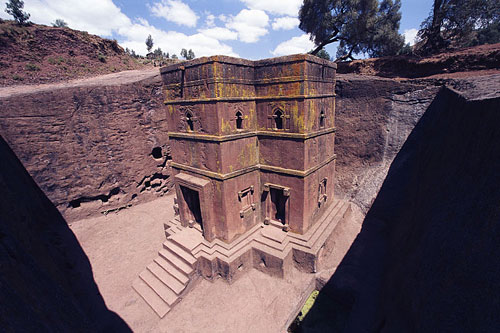
Looking down on Bet Giorgis church, Lalibela
The most remarkable of the Lalibela churches, called Bet Giorgis, is dedicated to St. George, the patron saint of Ethiopia. According to legend, when King Lalibela had almost completed the group of churches which God had instructed him to build, Saint George appeared (in full armor and riding his white horse) and sharply reproached the king for not having constructed a house for him. Lalibela promised to build a church more beautiful than all the others for the saint. The church of Bet Giorgis is a nearly perfect cube, hewn in the shape of a cross, and is oriented so that the main entrance is in the west and the holy of holies in the east. The nine windows of the bottom row are blind; the twelve windows above are functional. One of the most sophisticated details of Bet Giorgis is that the wall thickness increases step by step downwards but that the horizontal bands of molding on the exterior walls cleverly hide the increase. The roof decoration, often used today as the symbol of the Lalibela monuments, is a relief of three equilateral Greek crosses inside each other. The church is set in a deep pit with perpendicular walls and it can only be entered via a hidden tunnel carved in the stone.
Lalibela was the refuge for one of Christianity’s most interesting heresies, known as Monophysitism. This belief states that Christ was both divine and human before his incarnation but that his divine nature left his body and only reentered it after the Resurrection. First professed at the 2nd Council of Ephesus in 449 AD and soon thereafter condemned as heresy at the Council of Chalcedon in 451, Monophysitism spread through Asia Minor into Africa and Ethiopia. In different forms it survives today in the Syrian Orthodox church, the Armenian church, the Coptic church of Egypt and Ethiopian Orthodoxy.
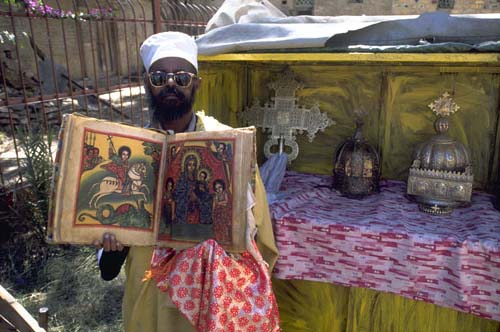
Ethiopian Orthodox priest with ancient Bible and crowns of Ethiopian kings, St. Mary of Zion, Axum
Other sacred sites, power places and pilgrimage shrines in Ethiopia:
- Abreha Atsbeha shrine near Wukro
- Ancient temple of Yeha, 25 kilometers east of Axum
- Rock-hewn churches of the Gheralta region, near Hawzen
- Pilgrimage church of St. Gabriel, near town of Kulubi
- Monastery of Debre Libanos
- Monastery of Debre Damo
- Monastery of Gishen Maryam
- Archaeological site of Tiya
- Muslim pilgrimage site at Shek Husen
- Church on island of Tana Kirkos, Lake Tana
Short film of Lalibela festival by Karoki Lewis.



 Martin Gray is a cultural anthropologist, writer and photographer specializing in the study of pilgrimage traditions and sacred sites around the world. During a 40 year period he has visited more than 2000 pilgrimage places in 165 countries. The World Pilgrimage Guide at sacredsites.com is the most comprehensive source of information on this subject.
Martin Gray is a cultural anthropologist, writer and photographer specializing in the study of pilgrimage traditions and sacred sites around the world. During a 40 year period he has visited more than 2000 pilgrimage places in 165 countries. The World Pilgrimage Guide at sacredsites.com is the most comprehensive source of information on this subject.